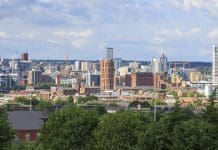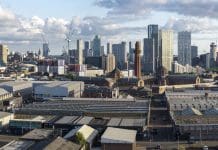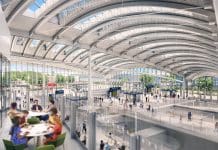Nicole Roe, director at planning consultancy Eden, discusses how the planning reforms are playing out in parliament and the importance of community-led placemaking at the heart of regeneration
After two years as housing secretary, Robert Jenrick was recently replaced by Michael Gove during Boris Johnson’s cabinet reshuffle, in a move to support the government’s new Department for Levelling Up, Housing and Communities. In part, the new department will oversee development of new, green infrastructure and housing.
Gove’s appointment came just as Jenrick’s planning reforms were causing a stir among Conservative MPs, with media headlines even linking the proposals to the fall of England’s high streets.
The proposed Planning Bill was designed to help reach a target of 300,000 new homes a year in England and traditional planning applications were set to be replaced with a zonal system. But with outcry from critics, the changes are likely to be diluted.
Nicole Roe is a director at Eden Planning who specialises in commercial and retail development and an expert on the High Street Task Force, an alliance of placemaking experts working to redefine our high streets.
Here, Nicole shares her views on the realities of the Planning Bill, the need for clarity on the government’s levelling up agenda and how placemaking and collaboration are key for the future of our high streets and regeneration of communities.
Communities would still be protected
Conservative MPs have previously referred to the planning reforms as a ‘developer’s charter’, implying the Planning Bill would create a free for all. However, local authority’s ability to impose Article 4 Directions has not been considered by those calling foul. There has been a broad misconception surrounding what the planning reforms mean for communities, the reality is that the use of Article 4 Directions can still protect communities by prohibiting development where a threat is posed.
It is all about balance. The concern for Jenrick’s changes implied all units could be changed with little to no approval; however, planning approval would still be required in the majority of cases. In a bid to quicken the planning approval process, the planning reforms were designed to streamline approval on units less than 150 sq m to free up time reviewing larger units. Even for those units under the threshold, the prior approval process does examine potential impacts on matters, such as transport, noise and impact on the historic environment.
As well as an Article 4 Direction working in favour of communities, the introduction of a new zonal system could work in the same way, enabling development that will benefit local people.
Zonal systems: a dynamic planning process
As we know, the planning reforms were designed to help reach the target of 300,000 new homes annually by the middle of the decade, using a new zonal system to speed up the planning process. This new system has received backlash with claims that it “strips” homeowners of their rights to object to new houses in their community.
A key part of a zonal system is to encourage residents to have their say when new plans are brought forward, and allocations are reviewed. To accompany this, development briefs can also be drawn up in consultation with the public, which could strengthen collaboration between local authorities and homeowners.
The zonal system could offer a new, dynamic way of working, especially as the backlog of planning applications continues to grow post-pandemic. It should also be noted that zonal planning is, in fact, a concept that is established and successful in many countries around the world, including The Netherlands, Germany and Japan.
It’s imperative that we see better collaboration between the respective departments involved in planning processes. We’re all working towards the same outcome and want to see our communities thrive. Placemaking also needs to be a key element, when considering residential areas and especially our high streets.
If regeneration is a focal point for the Department of Levelling Up, the first port of call is to shift the dependence on local authorities and bring in local companies and organisations to have their say.
There is a future for the high street
As we come out of the pandemic that has dominated the last 18 months, placemaking is more important than ever. To create a true sense of place for communities, we need to involve them in the decision-making process, taking them on the regeneration journey so that they can both have their say on their public spaces and have ownership of the end result. Responses to the proposed planning reforms have included concern for the future of our high streets and the decline of physical retail space. In an ever-changing world, retail is not the only solution for regeneration. It is widely accepted by councils, developers, and property professionals that there is too much ‘retail floorspace’, so changing the purpose of a few units isn’t going to negatively impact the high street. In contrast, removing secondary retail frontages that have high vacancy rates and are unattractive to modern occupiers will create more compact and vibrant centres. A more desirable high street increases footfall and, as a result, also increases passive surveillance, which can reduce inner-urban centre crime and anti-social behaviour.
Some councils have used ‘hard’ and ‘soft’ approaches to dealing with empty units on the high street. Rochdale is using its heritage as inspiration to breathe life into the town, with a new mural festival – free and open to the public. Rochdale Uprising involves a world-renowned artist adorning the buildings with art and, as part of the festival, there are workshops, gallery spaces, fringe events, screenings and artist talks.
Stockport Council has submitted a bid to the Future High Street Fun (FHSF) for a project in the town centre known as ‘StockRoom’. This scheme aims to renew and reshape Stockport town centre, overseeing investment in repurposing the M&S and BHS stores and the introduction of a learning and knowledge hub – further supported by the proposed arrival of Metrolink.
A high street that is rich with diverse businesses is surely more attractive than a saturation of retail businesses and can provide an opportunity for innovation. We also need to consider the fact that large parts of town centres are privately-owned and finding solutions will require working with the private sector and seeking investment.
Creative approaches to injecting life into the high street have the potential to drive greater footfall and establish a sense of community.
If we’re to transform our high streets, we need to see some significant change from the levelling up agenda alongside active interest in working with stakeholders and local delivery partners who have the direct knowledge needed to support regeneration.
Looking to the industry for answers
Ultimately, there is and always should be an opportunity for residents and the public to speak out about their local community. The Planning Bill wasn’t as radical as made out and it certainly wouldn’t create a ‘developer’s charter’. With this in mind, it’s important to look to the industry to cut through the white noise.
The government’s levelling up agenda is a welcomed opportunity to support regeneration as we emerge from the pandemic, but a tangible commitment to considering the public realm is imperative. There needs to be wider thinking on what “more housing” looks like, the careful consideration of empty retail space and the use of what is already there so we truly improve our high streets.
The last 18 months has been the catalyst for a lot of change and the new proposed planning reforms were just another part of that – especially as a spotlight is firmly on the reliability of current processes in planning applications.
Sometimes change is for the better.














